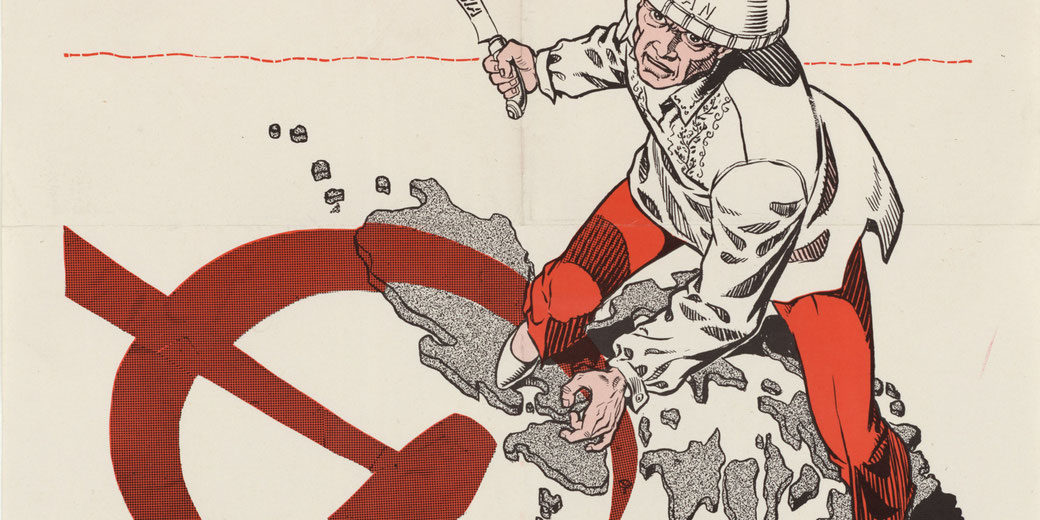Understanding the Cold War: What is the difference between capitalism and communism?

The Cold War, a period of political tension and military rivalry that lasted from the end of World War II until the early 1990s, was more than a geopolitical struggle between the Soviet Union and the United States.
At its core, it was a battle of ideologies, a clash between two fundamentally different visions of how society should be organized, governed, and economically structured.
On one side stood communism, a system that sought to eliminate social classes and promote collective ownership, as championed by the Soviet Union and its allies.
On the other side was capitalism, a system that emphasized individual entrepreneurship and free markets, as embodied by the United States and the Western world.
The basics of communism
Communism, as a political and economic ideology, seeks to create a classless society where the means of production are owned collectively.
Rooted in the works of Karl Marx and Friedrich Engels, communism emphasizes equality and the distribution of wealth according to need.
In a communist system, there is no private ownership of capital goods, and the state often plays a central role in planning and controlling the economy.
During the Cold War, the Soviet Union was the most prominent example of a communist state, and its policies and practices were often seen as the embodiment of this ideology.
The basics of capitalism
In contrast, capitalism is an economic system that emphasizes private ownership and the free market.
Under capitalism, individuals and businesses own the means of production and operate for profit.
The distribution of resources is determined by supply and demand, and prices are set by competition in the marketplace.
Governments may intervene to some extent, but they generally allow the market to function with minimal interference.
The United States, during the Cold War, stood as a symbol of capitalist ideals, promoting free trade, individual entrepreneurship, and economic freedom.
Why were they in conflict?
The ideological divide between communism and capitalism during the Cold War was profound and often irreconcilable.
While communism sought to eradicate social classes and promote collective welfare, capitalism emphasized individual initiative and personal gain.
The communist belief in state control contrasted sharply with the capitalist faith in market forces.
In the political arena, these differences often translated into opposing views on democracy, human rights, and governance.
Communist states tended to favor centralized control and one-party rule, while capitalist countries generally supported multiparty systems and democratic principles.

Economic differences
In the communist economic model, the state plays a central role in planning and controlling the economy.
The means of production, including factories, land, and resources, are owned collectively, and the government often sets production goals, prices, and distribution methods.
During the Cold War, the Soviet Union's command economy was the most prominent example of this approach.
Centralized planning aimed to meet the collective needs of the population, but it often led to inefficiencies, shortages, and a lack of innovation.
Contrary to the centralized planning of communism, capitalist economies rely on the free market to determine production, distribution, and pricing.
Private ownership and competition are the driving forces, and governments typically intervene only to regulate or correct market failures.
During the Cold War, the United States and Western Europe championed this model, promoting free trade, open markets, and individual entrepreneurship.
The ideological divide between communism and capitalism had far-reaching effects on global economics during the Cold War.
The world was often split into two economic spheres, with the Soviet-led Eastern Bloc and the U.S.-led Western Bloc engaging in separate trade agreements, financial systems, and development strategies.
This division extended to developing countries, where the superpowers vied for influence by promoting their respective economic models.
The Non-Aligned Movement, comprising countries that did not formally align with either bloc, sought to navigate this complex landscape, often adopting mixed economic approaches.
Differences in government structures
Communist political systems are characterized by a centralized government that often controls all aspects of political life.
During the Cold War, the Soviet Union's one-party system became synonymous with communist governance.
The Communist Party held a monopoly on political power, and opposition parties were either suppressed or controlled.
In this system, the state controlled not only the economy but also education, media, and other aspects of daily life.
Decision-making was highly centralized, and citizens had limited political freedoms and civil liberties.
Other communist states, such as China, Cuba, and East Germany, followed similar political structures, with variations in governance and control.
In contrast, capitalist political systems, particularly in the West during the Cold War, were often associated with democratic governance.
In countries like the United States, the United Kingdom, and Western European nations, multiparty systems allowed for competitive elections and a separation of powers.
Capitalism itself does not prescribe a specific political system, but in the context of the Cold War, it was often paired with democratic principles such as individual rights, freedom of speech, and rule of law.
Governments were typically limited in their control over the economy and private life, and checks and balances were implemented to prevent abuses of power.
The Cold War saw a complex interplay between democracy and authoritarianism within both communist and capitalist blocs.
While the Western capitalist countries generally promoted democratic values, there were instances of support for authoritarian regimes that aligned with their strategic interests.

How the different systems influenced their people
During the Cold War, both the communist and capitalist blocs engaged in extensive propaganda campaigns to promote their ideologies and discredit the other side.
State-controlled media in communist countries often portrayed capitalism as corrupt and exploitative, while Western media emphasized the lack of freedom and human rights under communism.
This battle for hearts and minds extended to film, literature, art, and even sports, where ideological messages were often woven into popular culture.
Education systems were also influenced by the ideological divide. In communist countries, education was often used to instill socialist values and loyalty to the party.
In capitalist countries, education emphasized democratic principles and individual achievement.
Academic exchanges, scholarships, and cultural diplomacy were tools used by both sides to spread their values and gain influence.
The Cold War had a profound impact on arts and literature, inspiring works that reflected the anxieties, hopes, and critiques of the time.
From dystopian novels like George Orwell's "1984" to the socialist realism of Soviet art, creative expression was both shaped by and responded to the ideological struggle.
Artists and writers often faced censorship or were used as cultural ambassadors, reflecting the complex relationship between art and politics.
The contrast between communism and capitalism was also evident in daily life and consumer culture.
The abundance and variety of consumer goods in the West were promoted as symbols of freedom and prosperity, while the austerity and uniformity of life under communism were portrayed as limitations.
This cultural competition extended to music, fashion, technology, and even food, reflecting the pervasive nature of the ideological divide.
The use of diplomacy and spying by both sides
Throughout the Cold War, numerous summits and agreements were held to manage tensions, negotiate arms control, and address other international issues.
Notable examples include the Geneva Summit (1955), the Cuban Missile Crisis negotiations (1962), the Strategic Arms Limitation Talks (SALT), and the Helsinki Accords (1975).
These diplomatic efforts often played a crucial role in preventing escalation and fostering cooperation, even amidst intense ideological rivalry.
The Cold War was also marked by extensive espionage and intelligence activities by both sides.
The CIA, KGB, MI6, and other intelligence agencies engaged in covert operations, surveillance, disinformation campaigns, and other clandestine activities.
The espionage battle not only influenced diplomatic relations but also contributed to technological advancements, cultural intrigue, and the mystique of the Cold War era.
The Non-Aligned Movement (NAM) emerged as a significant force in international relations during the Cold War.
Comprising countries that did not formally align with either the Eastern or Western blocs, NAM sought to navigate the Cold War's ideological divide and promote peaceful coexistence, economic development, and political independence.
Leaders like India's Jawaharlal Nehru, Egypt's Gamal Abdel Nasser, and Yugoslavia's Josip Broz Tito played key roles in shaping this movement.
The Cold War also influenced the functioning of international organizations like the United Nations.
The ideological divide often played out in the UN's chambers, affecting resolutions, peacekeeping missions, and international cooperation.
Other international organizations, such as the World Bank and the International Monetary Fund, were also shaped by the Cold War dynamics, influencing global economic policies and development strategies.
Places where communism and capitalism clashed
Germany: A Nation Divided
The division of Germany into East and West became a symbol of the Cold War's ideological divide. East Germany, under Soviet influence, adopted a communist system, while West Germany embraced capitalism and aligned with the Western bloc. The construction of the Berlin Wall in 1961 physically separated families and communities, reflecting the deep political and ideological rift. The fall of the Wall in 1989 marked the beginning of the end of the Cold War and the reunification of Germany.
Cuba: The Caribbean Cold War Flashpoint
Cuba's transformation into a communist state under Fidel Castro brought the Cold War to the Western Hemisphere. The Cuban Missile Crisis of 1962 brought the world to the brink of nuclear war, as the U.S. and the Soviet Union faced off over Soviet missiles in Cuba. Cuba's alignment with the Soviet Union and its support for revolutionary movements in Latin America made it a central player in Cold War dynamics in the region.
Vietnam: A War of Ideologies
The Vietnam War was a protracted and devastating conflict that pitted the communist North against the capitalist South, with significant involvement from both the U.S. and the Soviet Union. The war became a symbol of the ideological struggle, with profound impacts on Vietnamese society, American politics, and international relations. The war's legacy continues to influence contemporary debates about military intervention, human rights, and global governance.

Afghanistan: The Soviet Union's Vietnam
The Soviet invasion of Afghanistan in 1979 marked a significant escalation in the Cold War, leading to a decade-long conflict that became the Soviet Union's "Vietnam." The U.S. supported Afghan resistance fighters, turning the conflict into a proxy war. The war had lasting impacts on Afghanistan, contributing to ongoing instability, and played a role in the eventual dissolution of the Soviet Union.
Eastern Europe: The Struggle for Freedom
The countries of Eastern Europe, under Soviet influence, were central to the Cold War struggle. Movements for political reform and independence, such as the Prague Spring in Czechoslovakia and the Solidarity movement in Poland, challenged communist rule and inspired global support for human rights and democracy. The peaceful revolutions of 1989 marked a turning point, leading to the collapse of communist regimes across the region.
What do you need help with?
Download ready-to-use digital learning resources
Copyright © History Skills 2014-2025.
Contact via email
With the exception of links to external sites, some historical sources and extracts from specific publications, all content on this website is copyrighted by History Skills. This content may not be copied, republished or redistributed without written permission from the website creator. Please use the Contact page to obtain relevant permission.





